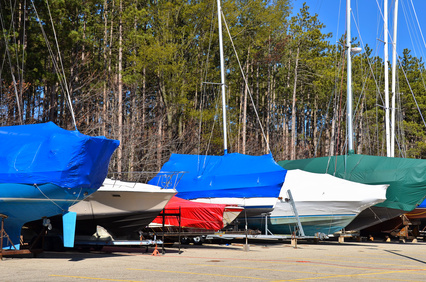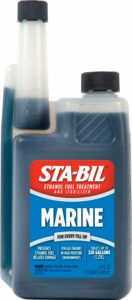
 The fall sees the end of the boating season for most of us. The colder months can take its toll on a boat left out in the harbor, pier side, or even in a covered trailer spot. This is why winterizing your boat and protecting it from the cold temperatures is absolutely essential for anyone who wants to extend the life of their precious asset.
The fall sees the end of the boating season for most of us. The colder months can take its toll on a boat left out in the harbor, pier side, or even in a covered trailer spot. This is why winterizing your boat and protecting it from the cold temperatures is absolutely essential for anyone who wants to extend the life of their precious asset.
How much time and effort you spend on maintaining your boat in the winter will define how your boat performs next season, and will also save on any additional maintenance costs you might have to incur come springtime. If you are counting on your insurance policy to take care of some of the repair costs for you, think again. There is a lot of damage resulting from neglect and a general lack of winter maintenance, which your insurance policy will not cover.
The best place to begin is to create a winter boat maintenance checklist of all the items that you need to get done. The owner’s manual of motor and your boat will be a salient and ideal place to begin for recommendations on the right sort of winterization for your boat. But here are a few generic but specific and necessary items that should find its way onto your checklist.
Choose the Storage Location
During the harsh temperatures of the winter season, it is important that you boat be out of the water if at all possible and preferably in a climate-controlled boat storage area. This is an expensive proposition though, and if it isn’t one that you can afford, at least try shrink wrapping your boat, which is a cheaper option. Essentially, your boat should be covered with a sturdy cover such as a tarp.
Wipe Down the Deck
The deck of your boat, especially a teak one, doesn’t need extensive treatments such as varnishing, but does well with a simple wipe down to remove salt water.
Clean the Hull
Make sure you clean the hull of your boat using the right cleaning agents and a sponge in gentle, circular motions. Avoid those that contain harmful chemicals or bleach which may compromise the state of your hull.
Sand a Steel Boat
Corrosion can cause a lot of damage to a steel boat. Keep corrosion at bay by sanding, scraping, chipping, and grinding down areas that are damaged.
Flush Inboard Engines
- Begin by running the engine and changing the oil while still warm to allow the oil to drain better.
- Remove and dispose of the oil filer.
- Fill up the engine again and check it for leaks.
- As your final step, use non-toxic antifreeze to flush the engine using an intake hose.
- Start up the engine and allow the circulation of the antifreeze until it begins to exit via the exhaust.
- Don’t forget to change the fluid in your transmission.
- Remove the spark plugs, spray each cylinder with fogging oil, and wipe the engine down with a towel sprayed with some fogging oil.
Care for Your Outboard Engines
- Check the fuel you have remaining in the tank and use fuel stabilizer to treat it.
- Use flush muffs with fresh water to flush the engine.
- Remove the cowl from the engine and with it running, spray some fogging solution into the air intakes located in the front.
- Keep the engine running and take out the fuel line from it. This helps to avoid build-up of deposits from any fuel that may have evaporated.
- Keep spraying the fogging solution until the engine shuts off.
- Treat the threads and propeller shaft with water resistant grease.
- Perform an oil change on the gear in the lower unit.
- Use a marvelous wax to polish and lubricate the exterior of the engine.
- Use a solution of soap and water to wash the engine down.
Inspect Stern Drives
- Check stern drives for barnacles or plant life.
- With the gear case drained, check the oil for any moisture which might point to leaking seals that you should immediately repair.
- Use a solution of soap and water to wash the lower unit.
- Make sure all fittings are greased and fluid levels in the lift or hydraulic pumps are inspected.
Store Outboards & Stern Drives in Down Position
If possible, you want to store your stern drives and outboards in the fully down position. This will help any rain water or snow melt drain out of the lower unit or drive instead of into it and help prevent a problem if it freezes again with water now inside the drive unit.
If you shrink-wrap your boat, consider shrink wrapping the drives also to help deter water intrusion even further.
Thoroughly Check Bilges
- Begin by using a solution of hot water, soap, and a stiff brush to clean oil spills.
- Spray the clean bilges with a moisture displacing lubricant.
- Prevent the water from freezing by adding some antifreeze.
Read Your Manufacturer’s Manual for Fuel Care
- Check your manufacturer’s manual for exact details on how to deal with your fuel tanks.
- Some suggest adding stabilizer to the fuel, while others recommend filling fuel tanks. There is less condensation that occurs in tanks that are full.
- Change the water separator and fuel filters.
Drain Fresh Water Tanks
- Make sure you drain the hot water heater and the fresh water tank completely.
- Disconnect the in and out lines of the water heater and reconnect them together.
- Add non-toxic anti-freeze into the hot water system.
- Keep all facts turned on until the antifreeze can be seen emanating from there.
Keep Your Interiors Bare
- Make sure that your interiors are as bare as possible. Remove flares, fire extinguishers, fenders, lines, electronics, and so on.
- Clean your drawers and lockers out completely.
- Clean out your freezer and refrigerator.
- Turn cushions on edge to allow air to circulate around them.
- Keep mildew at bay by installing a dehumidifier or using odor and moisture absorber products.
Remember Each Boat is Different
Your boat may have additional measures that need to be taken. Contact the manufacturer if your manual doesn’t cover winterizing and storage. It also won’t hurt to find an online usergroup specific to your boat and see what other people have done – including learning from their mistakes.
What Else?
Do you do something that isn’t listed? We’d love to hear about it – just leave us a comment in the box below.


Leave a Reply